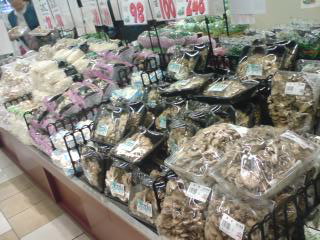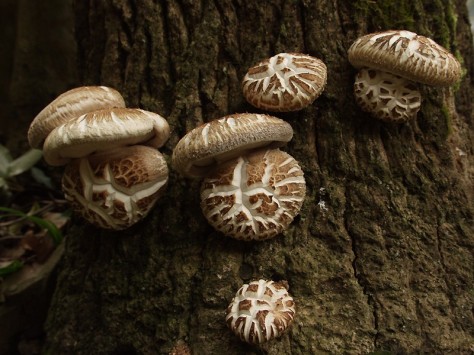
(Mushrooms at at a Shizuoka Supermarket)
I don’t intend to talk about wild mushrooms here as I would need a very thick book to post!
Japan is arguably the country cultivating the greatest number of varieties (new ones appear and disappear every year!), so I will limit myself to give information on at least some of them and furthermore introduce most varieties I have found in Japanese supermarkets (most of them should be available in many countries).
SHIITAKE

FACTS:
Shiitake/Lentinula Edodes (Black Forest Mushrooms) are native to China but have been grown in both Japan and China since prehistoric times[2]. They have been cultivated for over 1000 years; the first written record of shiitake cultivation can be traced to Wu Sang Kwuang, born during the Song Dynasty (AD 960–1127). However, some documents record the uncultivated mushroom being eaten as early as AD 199.
Fresh and dried shiitake have many uses in the cuisines of East Asia. In Chinese cuisine, they are often sauteed in vegetarian dishes such as Buddha’s delight. In Japan, they are served in miso soup, used as the basis for a kind of vegetarian dashi, and also as an ingredient in many steamed and simmered dishes. In Korean cuisine, they are commonly used in dishes such as bulgogi (marinated grilled beef), jjigae (stews), and namul (sauteed vegetable dishes). In Thailand, they may be served either fried or steamed.
Shiitake are often dried and sold as preserved food in packages. These must be rehydrated by soaking in water before using. Many people prefer dried shiitake to fresh, considering that the sun-drying process draws out the umami flavour from the dried mushrooms by breaking down proteins into amino acids and transforms ergosterol to vitamin D. The stems of shiitake are rarely used in Japanese and other cuisines, primarily because the stems are harder and take longer to cook than the soft fleshy caps. The highest grade of shiitake are called donko in Japanese.
Extracts from shiitake mushrooms (such as ichtyol) have also been researched for many other immunological benefits, ranging from anti-viral properties to possible treatments for severe allergies, as well as arthritis.
The Japanese actually consume them from their raw form more than in any other country.
FACTS:
-Season: best in October~March for outdoors cultivation
-Main beneficial ingredients: Vitamin B1, B2, B6, c, N6, Ergosterol, Lentinan, Fibers, Potassium, Magensium, Phosphorus.
TIPS:
-Loosely wrap them in clean Newspaper or Kitchen Paper and store them in fridge away from the light.
-Choose specimens with unbroken “umbrella” and no black marks under.
-Fresh Shiitake are best enjoyed for their taste by keeping their cooking simple such as fry them over a grill with a dash of soy sauce and sake!
-If you want to dry them, do so under sunlight for best taste!
-Preserve dried shiitake in fridge to avoid mold and insects!
HEALTH FACTS:
-Dried shiitake contain more Vitamnin D!
-Combined with burdock root, or broccoli, or carrot, or asparaguses, helps combat cancer and helps with skin rejuvenation.
-Combined with konbu/seaweed, or spinach, or sardines, or sesame, helps combat bone diseases, activates blood circulation, helps combat nervous problems and rheumatism.
-Combined with sesame, or walnuts, or kabocha, or mayonnaise, helps combat ageing.
-Combined with celery, or cuttle fish/squid, or octopus, or mackerel, helps reinforce liver, combats high blood pressure, heart diseases and artery hardening.
RECOMMENDED RELATED SITES:
Warren Bobrow, Bread + Butter, Zoy Zhang, Hungry Neko, Think Twice, Frank Fariello, Mangantayon, Hapabento, Elinluv Tidbit Corner, Tokyo Terrace, Maison de Christina, Chrys Niles,Lexi, Culinary Musings, Wheeling Gourmet, Social Culinaire, Sushi Nomads, Cook, Eat & Share, Gourmet Fury, 5 Star Foodie
Please check the new postings at:
sake, shochu and sushi
—————————————-
日本語のブログ
—————————————-